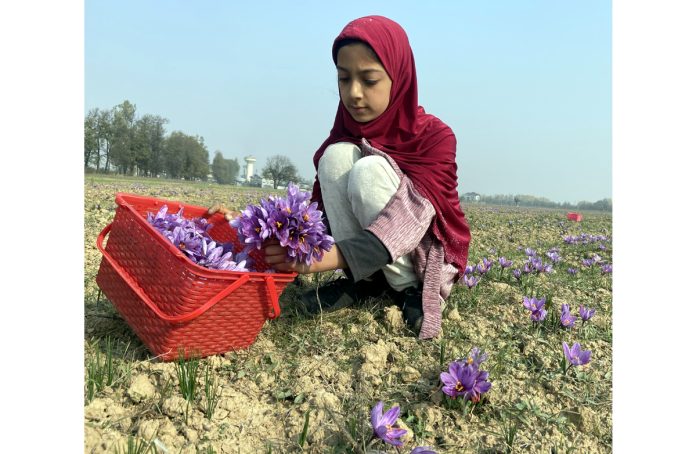
Suhail Bhat
Srinagar, Nov 5: The uplands of Pampore in South Kashmir have undergone a breathtaking transformation as vibrant purple saffron flowers have finally blossomed after a 10-day delay caused by a drop in temperature, igniting hopes of a promising saffron production this year.
Saffron growers in Pampore area of South Kashmir are thrilled to witness their fields adorned with purple saffron blossoms. In recent years, they have yearned for such a sight, as adverse weather conditions significantly reduced the blossom. These growers have endured a challenging drought cycle that severely impacted crop production. However, the timely rainfall has brought relief to the distraught growers in the form of hope for a good yield.
Saffron growers, accompanied by their children, were seen flocking to the fields on Sunday with wicker baskets in hand to pick these beautiful purple flowers. They were delighted with the density of the blooming saffron, which arrived after a nearly 10-day delay.
Growers attribute this positive change to timely rainfall, which nature has once again bestowed upon them, revitalizing their prospects for a good yield this year. “We usually gather 3-4 batches of flowers, with the largest batch typically around the 25th to the 27th, but this year, that schedule was disrupted. We were concerned about a potential decline in production, but now we have picked the largest batch of the crop. It is safe to say that nature has once again come to our rescue,” Abdul Ahad Rather, a saffron grower, told the Excelsior.
However, 65-year-old Ghulam Nabi claimed that this year, the saffron flowering cycle has returned to its original timing, reminiscent of 30 years ago. “This promising change signals expectations of a substantial harvest this year, bringing a sense of relief and excitement to the growers,” he said. He, however, said the lost production could never go back to what they used to have three decades ago.
Abdul Majeed, president of the Saffron Growers Association, said that they were expecting the best saffron production since 2014. “The timely rainfall has once again come to the rescue of growers and given them hope of a good crop this year,” he said.
Growers are optimistic about the increased crop yield, providing them with renewed hope for the future of their crops. “While the increase may not be substantial, it is enough to give growers hope. Preliminary estimates suggest that the output could be higher this year,” he said.
The growers, however, claimed that the Government has again failed to complete the irrigation system and that a probe should be ordered on how the national saffron mission was established. “Those responsible for its failure should be penalized and booked under stringent laws,” a grower said.
The irrigation system is part of the National Saffron Mission, which was introduced to address the area”s drought issues. It involves laying water delivery pipes and installing sprinklers. Despite government efforts, many of the bore wells intended for irrigation are currently non-functional. The “National Saffron Mission,” with a budget of Rs 500 crore, was approved by the Central Government in 2010 with the aim of boosting saffron production and expanding the saffron cultivation area.
However, despite this initiative, launched in collaboration with the local Government and intended to increase production from 3 kg to 5 kg per hectare, it has yet to yield substantial results after 12 years.

